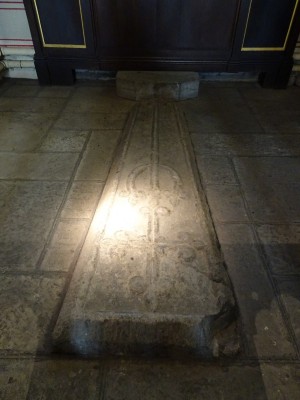GA-STNL-0375
f "CRUSADER'S TOMB"'! +ADAM BVR[E] [?GIST] DEVS DE SA ALME EA^MER CII + QVI POR SA ALME PRIERA VING GORS DE PARDVN AVERA The above can be roughly translated as follows Here lies Adam Bure. May God have mercy on his soul. Whoever will pray for his soul will have twenty day's indulgence.
A trapezoidal slab with a triangular-shaped end. It is 13th - early 14th century in date and has a Norman-French Ins. around its edges. The edges are chamfered and the right hand edge is slightly hollowed. The slab bears a two-line cross consisting of two wide bands with an incised line between them and ending with a long shaft. The upper part has four foliated terminals with a fleur-de-lis at the end of each arm. There is a central boss at the junction of the arms and shaft. The so-called *Crusader's Tomb“ in what is now known as the Chapel of Christ is a coffin-shaped slab of limestone of 13th century type. The inscription is one of a small group of Norman-French inscriptions which survive mainly from the South East and East of the country. This stone (Cat. No. 375) is one of the earliest to survive from St. Nicholas'. Drawing by Jim Higgins. The lower part of the cross-shaft has a lobed top and a fleurs-de-lis-shaped bottom. A pair of upturned "U"-shaped arms spring from the shaft and these also have fleurs-de-lis-shaped terminals. The stone has been broken across the top and repaired in modem cement. The upper left hand comer has a modem repair and part of the original Ins. which included the name of the person commemorated is now lost. The Ins. is Inc’d. and some of the letter-forms are difficult to interpret. A small row of three dots occurs between many of the words. A gap occurs in between die "AL" and "ME" of the Ins. where there is a flaw in the stone. Anon (1895) gives a fairly good reading of the Ins. (by Canon Keane) as follows + - - - D BVRE - - GIST DEVS DE SA ALME MERCI + QVI POR SA ALME PRIERA VINT GORS DE PARDUN. Cooke (1895) also mentions the stone in passing in the same journal as Anon (1895) but does not give the inscription. Several parallels for the formula used in the Ins. occur at Youghal for example. A thirteenth century slab bearing an effigy at St. Mary's Collegiate Church at Youghal bore an Ins. in Norman-French and was cut in Lombardic script. Hayman (1854), 113 gives a reading of the Ins. on it as follows [MA]THEV LE MERCER GIT YCE CELI RE PRIE PVR LE ALME ...IOVRS DE PARDVN (Mathew Le Mercer lies here. Whoso prays for his soul shall have ... days of pardon). According to Hayman ibid, footnote 1 "Matthew le Mercer" was collector of the customs at Youghal and appears to have died at the close of the thirteenth or commencement of the fourteenth century. Another parellel for the formula used in the Ins. is found on a slab from the Dominican Priory, in Youghal. The slab according to Hayman (1855), 336 was decorated on its upper surface with "a rich fleureed cross" a Lombardic Ins. running down its side. The first segment of this was "conjectually read" as ... CEVAL...AVSE but on the second segment Hayman could "indubitably trace" CEV DE LOR ALMES EIT MERCI PRIE POUR LOVR...



